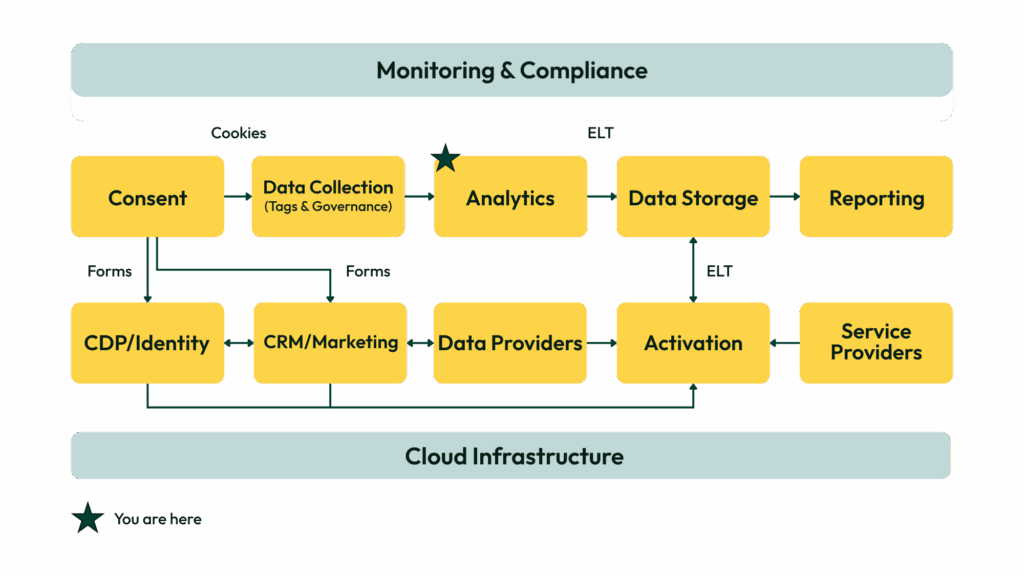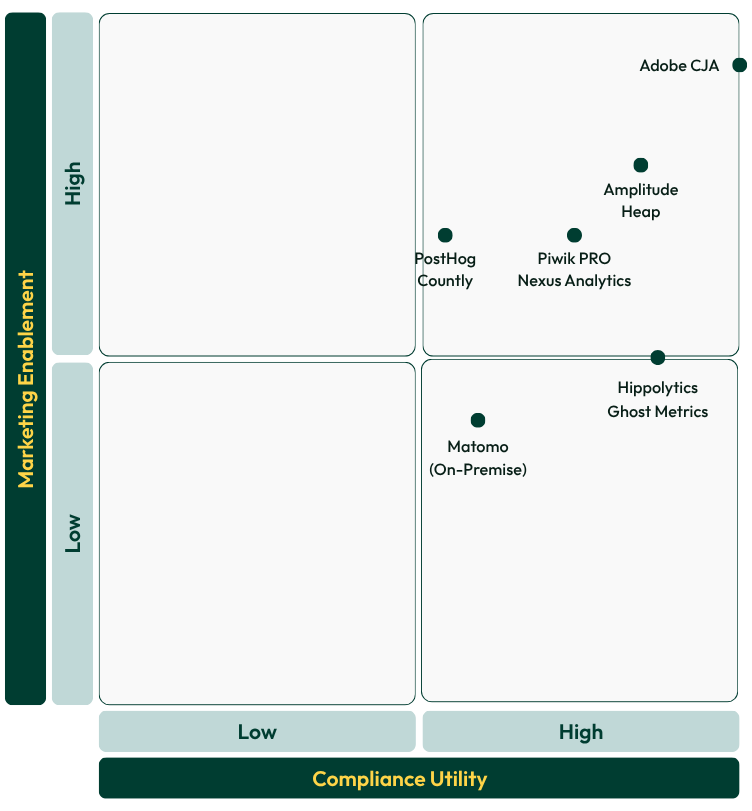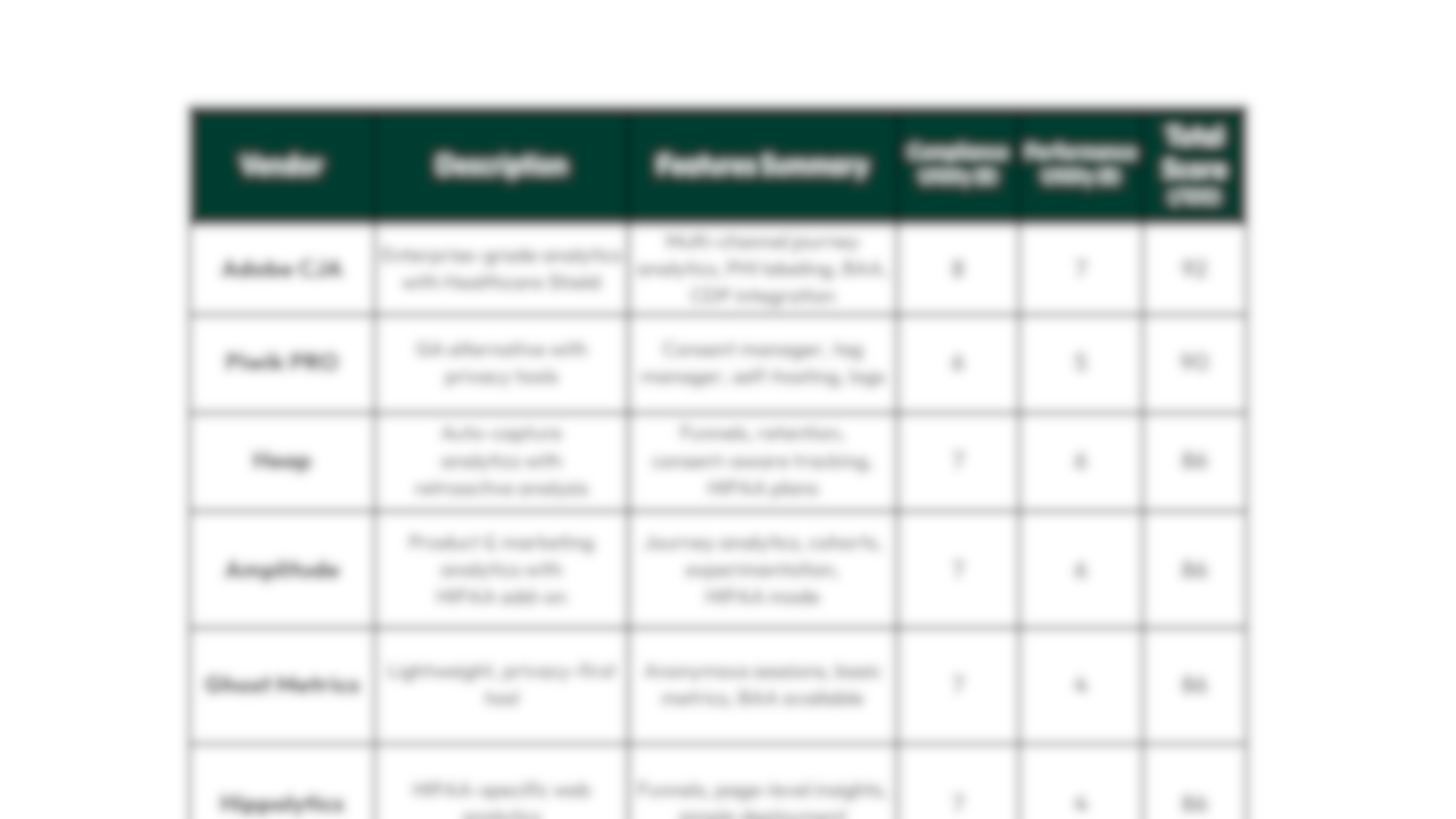The Ultimate Guide to Privacy-Compliant Analytics Platforms
Table of Contents
In healthcare, analytics platforms extend beyond marketing tools and act as compliance-critical infrastructure.
Published on October 16, 2025
Every data point, whether it’s a page view on a symptom checker, a patient clicking through an appointment reminder, or a visitor abandoning a scheduling form, risks becoming a privacy violation if incorrectly collected, stored or shared. That reality has transformed the analytics conversation from one of convenience, utility, and performance to one of privacy, compliance, and defensibility.
The stakes are high. Increasingly stringent HHS guidance, a kaleidoscope of state-level privacy regulations (21 states and counting), increased FTC enforcement and a barrage of civil suits and demand letters (most of which go unreported) make clear that the intersection between privacy regulations and must be taken very seriously.
This guide was built for healthcare marketing, compliance, and IT leaders navigating this new environment. Our focus is twofold:
1. Privacy & Compliance Utility – How analytics platforms enforce HIPAA safeguards, enable PHI-safe tracking, and support auditability.
2. Performance Utility – How these platforms still allow marketers to measure patient journeys, optimize campaigns, and personalize experiences without sacrificing compliance.
What You’ll Find Here and What You Won’t
You will not find vendor hype here. Instead, this guide is vendor-neutral, evidence-backed, and grounded in real-world audits, enforcement trends, and our experience implementing (and sometimes removing and replacing) these platforms in healthcare environments. Our goal is to help you understand:
- What defines a privacy-compliant analytics platform
- Why they are necessary in healthcare today
- How to evaluate platforms for both compliance and performance
- Which vendors are best positioned to serve regulated organizations
As with our other Ultimate Guides, we’ll provide scorecards, evaluation rubrics, and the Wheelhouse Point of View (clearly designated) throughout. Use this guide as both a reference and a roadmap to make confident vendor selections, to architect your analytics stack for compliance, and to future-proof your measurement strategy in a privacy-first healthcare world.




Why Healthcare Needs Privacy-Compliant Analytics
Few industries face greater scrutiny over digital data than healthcare.
The Compliance Backdrop
Since the 2022 OCR bulletin on tracking technologies, regulators have made clear that standard analytics implementations can violate HIPAA. Collecting IP addresses on pages with condition-specific content, transmitting URLs with diagnosis terms, or linking behavior to authenticated patient portals all count as impermissible disclosures if not properly safeguarded.
- OCR enforcement: Healthcare organizations have been investigated, fined and sued for their use of generally accepted tracking technology. Meta’s tracking pixel, user experience testing platforms and Google Analytics have all triggered legal action and fines for HIPAA-covered entities.
- State-level privacy regulations: State-level laws like Washington’s My Health My Data Act, California’s CPRA and CCPA and Maryland’s Online Data Privacy Act (which came online Oct 1, 2025) are illustrative of the increasingly complex and restrictive tapestry of privacy regulations that healthcare marketers must navigate.
The Risks of Non-Compliant Analytics
Client-side tracking leaves healthcare organizations exposed to compliance risk. Client-side trackers such as the Meta pixel send data directly to third parties and the data libraries that govern what data is collected by these pixels may be updated at any time by these third parties.
Related operational risks include:
- PHI leakage – Query strings, IPs, or form inputs can inadvertently expose identifiers.
- Audit failures – Without BAA-backed logging, teams cannot demonstrate defensibility during investigations.
- Operational blind spots – Compliance-driven shutdowns of tools like GA4 can leave marketing teams flying blind.
- Patient distrust – Privacy breaches erode confidence and damage brand equity in ways that outlast legal actions.
In contrast, server-side analytics implementations enable the control and PHI protections required in regulated environments. Explore our deep dive on why this shift is essential for HIPAA compliance and marketing performance.
The Value of Privacy-Compliant Analytics Solutions
When implemented correctly, privacy-compliant analytics solutions allow healthcare organizations to:
- Safely measure patient journeys across web, app, call center, and CRM environments without PHI exposure
- Enable first-party data strategies by ensuring analytics pipelines are secure, server-side, and consent-aware
- Support marketing agility with compliant funnel analysis, retention metrics, and cohort building
- Prove ROI with PHI-safe attribution models that satisfy compliance teams while supporting campaign optimization
Role in the Healthcare Stack
Privacy-compliant analytics platforms sit in the data collection and analysis layer of the healthcare MarTech stack. Positioned after consent enforcement and tag governance, but before data storage and BI, they are the checkpoint where behavioral data is captured, modeled, and prepared for downstream use.
- Upstream Dependencies: Analytics relies on CMPs to enforce patient consent and on Tag Management Systems and server-side routing to control what is collected and how data is routed.
- Downstream Outputs: Analytics event streams feed secure warehouses, CDPs, and BI tools for reporting, attribution, and activation.
In other words, analytics is the bridge between raw behavioral events and enterprise-grade insights. If this layer is not compliant, every downstream output, from dashboards to marketing activations, becomes legally and operationally compromised.

Interdependencies That Matter
- Data Layer Discipline: Poorly structured tag management produces incomplete or noncompliant analytics.
- Activation Flows: Moving away from client-side analytics requires reconsidering how analytics outputs connect to ad platforms. Often, these pathways must shift into CDPs or server-side environments.
- Governance Alignment: Analytics is the point where marketing’s need for insights and compliance’s need for defensibility converge.
Core Capabilities of a Healthcare-Grade Analytics Platform
A privacy-compliant analytics platform must protect PHI, enforce consent, and still provide marketers with actionable insights. The following capabilities define what “good” looks like for healthcare analytics:
Secure Data Collection & PHI Filtering
Platforms must allow HIPAA-compliant event ingestion, whether through server-side pipelines, private cloud, or self-hosted deployments. Key safeguards include:
- Encryption at rest and in transit
- Field-level suppression of identifiers (e.g., IP addresses, URLs, user IDs)
- Session scrubbing and anonymization options
Consent-Aware Tracking
Analytics must not run until patient consent has been validated. This requires:
- Integration with CMPs so events are only collected when consent is granted
- Real-time suppression or transformation of payloads when consent is denied
- Retroactive analysis that respects consent preferences over time
Governance & Tag Integration
Analytics must operate as part of a broader privacy stack. Capabilities include:
- Built-in rules for data minimization (only “minimum necessary” data is retained)
- Integration with server-side tag managers to control event flow
- Role-based access controls and audit trails for all event activity
Auditability & Data Retention
Compliant platforms must make compliance review seamless by providing:
- Immutable logs of all events and changes
- Configurable data retention aligned with HIPAA and state laws
- Exportable reports to demonstrate defensibility during audits
Implementation in a Healthcare Stack
Even with the right analytics platform, compliance and effectiveness depend on implementation. Missteps at this stage often create blind spots for marketing or compliance risks for the organization.
1. Deployment Pathways
Healthcare teams typically choose one of three paths:
- In-house deployment – IT and analytics teams configure and maintain the platform directly. Offers maximum control but requires deep technical and compliance expertise.
- Hybrid model – A mix of in-house oversight and third-party support (often through managed hosting or consulting partners). Useful for organizations that need agility but lack internal bandwidth.
- Fully managed service – Outsourced deployment and monitoring by a partner specializing in HIPAA-compliant analytics and willing to sign a Business Associate Agreement. Best for lean teams prioritizing speed and defensibility.
2. Integration with the Privacy Stack
Analytics must be placed in sequence within the privacy-first architecture:
- Consent Management Platform (CMP): Enforces whether analytics can run at all.
- Tag Management / Server-Side Routing: Ensures only approved, PHI-safe events are forwarded.
- Analytics Platform: Ingests, models, and secures behavioral data for analysis.
- Data Warehouse & BI Tools: Join analytics with CRM/EHR data in a HIPAA environment for visualization.
3. Common Implementation Mistakes
- Assuming BAA = compliance. Signing a contract doesn’t prevent PHI leakage. Proper configuration, suppression of identifiers, and consent enforcement are still required.
- Over-reliance on client-side tracking. Pixel-based tracking can expose IP addresses, URLs, or identifiers before consent is enforced.
- Underestimating change management. Teams accustomed to GA workflows often resist shifting to new schema models. A data governance plan and stakeholder alignment are critical.
- Failing to plan for activation. GA historically powered direct integrations with ad platforms. Without GA, marketers must design alternative activation pathways (via CDPs or CRM pipelines).
4. Patterns for Success
- Adopt server-side data collection wherever possible to keep control within your environment.
- Pair with a CMP to ensure consent enforcement gates analytics execution.
- Invest in governance upfront. Define your data layer, establish rules for PHI suppression, and create audit-ready documentation.
- Segment stakeholder training. Marketing teams need UI training, IT teams need configuration practices, compliance teams need audit validation.
- Phase in enhancements. Begin with core funnel and cohort tracking, then layer on optional utilities (A/B testing, session replay) once governance is stable.
Market Landscape
The privacy-compliant analytics market in healthcare clusters into four practical segments:
Enterprise Suites With HIPAA Programs
Adobe Customer Journey Analytics sits at the top for full-fidelity, PHI-aware analytics when paired with Healthcare Shield and a BAA. It blends web, CRM, and clinical data, with data labeling and access controls suited to large health systems. Piwik PRO also straddles this segment, offering a familiar GA-like interface plus consent and tag tools in HIPAA-ready configurations.
Healthcare-Native Platforms
Vendors purpose-built for regulated journeys, often with BAAs by default and privacy-first positioning. Nexus Analytics exemplifies this category with journey visualization and cohorting designed for HIPAA workloads. However, unlike Adobe or Piwik PRO, Nexus currently lacks broad evidence of live healthcare deployments, which tempers its ranking. We classify it as a promising, early-stage option rather than a market leader.
Modern Product Analytics With HIPAA Options
Heap and Amplitude offer robust funnels, cohorts, and experimentation with HIPAA programs or add-ons available. They are widely adopted by mixed marketing and product teams, and score well for balancing compliance with usability, though they are not as enterprise-scaled as Adobe.
Self-Hosted and Open-Source Options
Countly, PostHog, and Matomo provide on-prem or private cloud deployments that keep PHI entirely within your environment, appealing when first-party control is paramount. These options deliver strong compliance utility but place more operational burden on internal teams.
Evaluation Framework
Privacy-compliant analytics platforms must enforce HIPAA compliance and deliver the measurement fidelity marketing teams require. We created an evaluation framework weighted specifically for these healthcare use cases.
1. Privacy & Compliance (30%)
This is the non-negotiable category. Platforms must demonstrate:
- Availability and willingness to sign a BAA
- HIPAA-compliant ingestion and processing of events
- Data minimization, masking, or filtering of identifiers
- Encryption in transit and at rest, plus audit logging
A platform that fails here is not viable in healthcare, regardless of its analytics utility.
2. Healthcare Fit (25%)
Not every “HIPAA-ready” vendor has real-world healthcare deployments. We prioritize tools with:
- Proven use in hospitals, health systems, or telehealth providers
- Support for condition-specific journeys (e.g., PHI-safe tracking on oncology or cardiology pages)
- Documentation and support teams versed in healthcare environments
3. Architecture & Flexibility (20%)
Flexibility matters, especially for teams deciding between SaaS and self-hosted models. Key factors include:
- Server-side deployment or private cloud hosting options
- Compatibility with AWS, Azure, or GCP HIPAA programs
- Support for both real-time and batch event handling
- Availability of SDKs and APIs for app and mobile tracking
4. Governance & Consent Controls (15%)
Analytics does not exist in isolation. Platforms should integrate with CMPs and TMS to enforce data governance at the point of capture. Look for:
- Conditional tracking based on consent state
- Ability to configure rules for event suppression or anonymization
- Role-based access and traceability of events across environments
5. Usability & Support (10%)
Even the most compliant tool fails if marketing and analytics teams cannot use it effectively. This category measures:
- Intuitive interfaces for both technical and business users
- Quality of onboarding and documentation
- Availability of dedicated healthcare support or training resources
Vendor Scorecard
To support direct comparison and procurement decision-making, we have translated the evaluation framework into a vendor scorecard. This table summarizes how each privacy-compliant analytics platform performs across privacy, healthcare fit, architecture, governance, and usability criteria.
Dual Utility Compliance vs. Performance
Selecting analytics platforms in healthcare is rarely a straight feature race. Instead, teams must balance two forces that often pull in opposite directions:
- Compliance Utility – the degree to which a platform enforces HIPAA safeguards, contracts, and PHI governance.
- Performance Utility – the degree to which it empowers marketing teams with funnels, cohorts, experimentation, and orchestration.
The Dual Utility Framework scores each platform along these two axes (out of 8), then maps vendors into quadrants that highlight trade-offs between privacy enforcement and marketing impact.
The matrix reveals four quadrants:
- Top-right (High Compliance, High Performance): Tools that support privacy enforcement and marketing flexibility
- Bottom-right (High Compliance, Low Performance): Strong privacy tools that don’t directly contribute marketing utility
- Top-left (Low Compliance, High Performance): Tools that are exclusively focused on marketing performance, and that require high levels of support or configuration to be compliant.
- Bottom-left (Low Compliance, Low Performance): Should be avoided entirely in HIPAA-regulated settings

What The Scores Show
- Adobe CJA remains the only platform firmly in the top-right quadrant, combining full compliance maturity with enterprise-grade performance. It stands apart as the category leader.
- Piwik PRO ranks second overall, balancing strong compliance (BAA or self-hosted models) with solid, if less innovative, performance. Its familiar GA-like interface makes it attractive to teams transitioning away from Google Analytics.
- Heap and Amplitude show strong balance: both deliver high compliance with modern product-style analytics, making them particularly well-suited for marketing and product teams that need funnels, cohorts, and app measurement without heavy developer lift.
- Ghost Metrics and Hippolytics emphasize compliance-first architecture with BAAs and privacy-native design, but their limited feature depth keeps performance utility in the lower range.
- Nexus Analytics, though purpose-built for healthcare, lacks public proof of adoption. We’ve adjusted its scores downward, reflecting solid compliance intent but limited evidence of operational maturity or market traction.
- Countly, PostHog, and Matomo achieve acceptable compliance via self-hosting and governance, but their performance is constrained by usability, technical overhead, and reliance on BI layers for deeper reporting.
Future Outlook
Privacy-compliant analytics is no longer an optional layer in healthcare, it is becoming a foundational requirement. The next few years will accelerate that trend as both regulatory expectations and technical capabilities evolve.
1. Regulatory pressure will only increase.
- OCR enforcement is expanding. The 2022 bulletin on tracking technologies was just the beginning. Recent cases show regulators are scrutinizing not only traditional analytics but also “shadow data” flowing through ad platforms and third-party pixels.
- State-level laws are multiplying. Washington’s My Health My Data Act and California’s CPRA are harbingers of broader state action. These laws broaden what counts as “health data” and raise the compliance bar beyond HIPAA.
- FTC and AGs are active. Federal and state agencies are sending a clear message: the era of “gray zone” analytics in healthcare is over.
2. First-party and server-side models will still dominate.
- Chrome’s third-party cookies remain for now. Google stepped back from a full phaseout and moved toward user choice and Privacy Sandbox APIs. That means no hard cutover date, but the strategic direction remains privacy-forward.
- Plan for a world with unstable third-party signals. Even without a Chrome sunset, third-party identifiers continue to degrade due to browser differences, privacy features, and platform policies. First-party IDs, consent-aware server-side collection, and private warehousing will keep gaining importance.
- Server-side event collection becomes default. Healthcare teams will increasingly favor server-side GTM patterns and first-party IDs, with PHI cleansing before any external destinations. Your Compass model is a practical path here.
3. Platforms will converge with CDPs and consent.
- Blurred category lines. As seen with Ours Privacy and Freshpaint, the distinction between analytics, CDPs, and consent enforcement is narrowing. Future platforms may bundle governance and analysis together to win share in healthcare.
- Integrated consent enforcement. Analytics will need to consume consent states natively, ensuring that every event respects user choices without custom engineering.
4. AI will reshape performance utility.
- Predictive analytics. AI-driven insights, churn prediction, care pathway optimization, audience segmentation, will expand what analytics can deliver.
- Privacy-preserving AI. Expect emphasis on differential privacy, federated learning, and de-identified modeling techniques to enable compliant personalization at scale.
- Caution required. Healthcare marketers must balance AI-driven optimization with transparency and defensibility in regulated environments.
5. Healthcare teams must build for adaptability.
- Enterprise readiness. Platforms like Adobe CJA will remain anchors for large health systems, while lighter tools (Heap, Amplitude, Piwik PRO) will evolve for more agile teams.
- Custom approaches. Many organizations will follow hybrid models, using GA4 server-side with a first-party warehouse like Compass to maintain compliance while maximizing ROI.
- Continuous governance. The “one-and-done” compliance model is gone. Success will depend on ongoing collaboration between Marketing, IT, and Compliance.
Where This Is Heading
Privacy-compliant analytics is no longer a gray zone, it is the backbone of compliant digital engagement. The winners in healthcare will be organizations that:
- Establish first-party governance and data ownership.
- Adopt server-side collection as the default.
- Invest in platforms that deliver both compliance certainty and marketing agility.
- Treat analytics as a shared responsibility across marketing, IT, and compliance.
At Wheelhouse, our work has shown that the path forward isn’t about choosing between compliance and insight. It’s about building analytics ecosystems that deliver both, sustainably.
About This Guide
This guide was created through a collaborative process that blended the speed and structure of AI with decades of real-world healthcare marketing experience.
We used AI tools to help us gather, synthesize, and organize foundational information about this category and the vendors included. These tools supported brainstorming, research structuring, and drafting early content sections. We also used AI to transcribe and analyze hours of interviews with our internal experts, vendor partners, and healthcare industry leaders, transforming those conversations into the practical insights shared throughout.
Every section was manually reviewed, edited, and enriched by our team to ensure accuracy, nuance, and relevance to healthcare marketers navigating complex privacy challenges. We refined the structure iteratively, using both AI suggestions and human judgment to create a guide that is clear, credible, and actionable.
While AI helped us work more efficiently, it’s the combination of technology and lived experience that gives this guide its depth and utility.
Created by Wheelhouse DMG
Resources
Legal Disclaimer: The information contained in this communication should not be construed as legal advice on any matter. Wheelhouse DMG is not providing any legal opinions regarding the compliance of any solution with HIPAA or other laws and regulations. Any determination as to whether a particular solution meets applicable compliance requirements is the sole responsibility of the client and should be made after consulting with their own legal counsel.
More Ultimate Guides
Explore our other Ultimate Guides to help you navigate your privacy-compliant MarTech needs.






